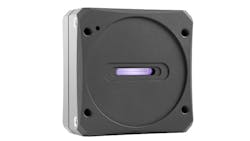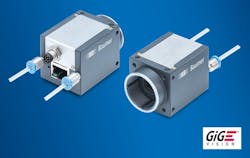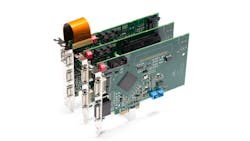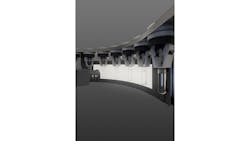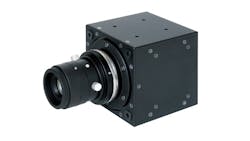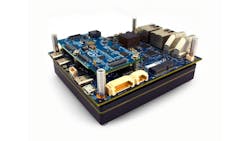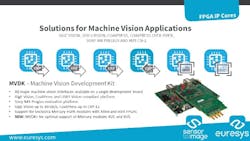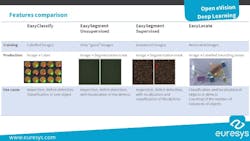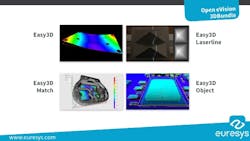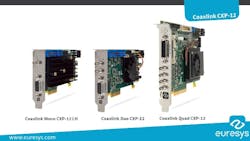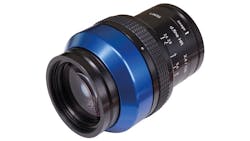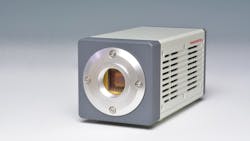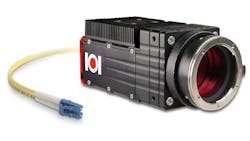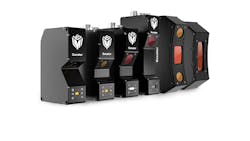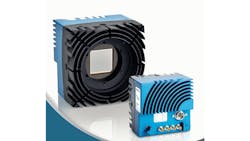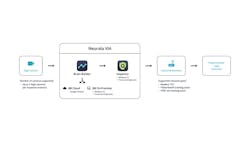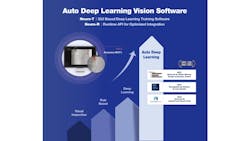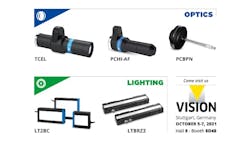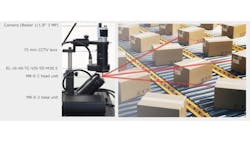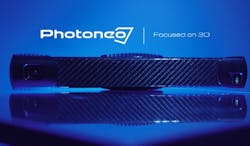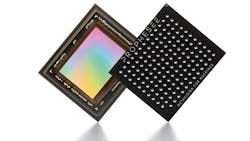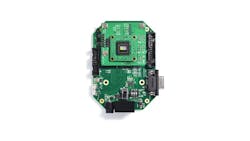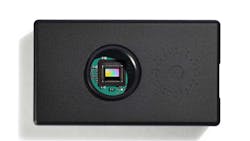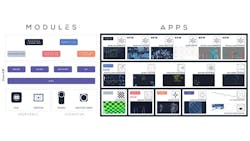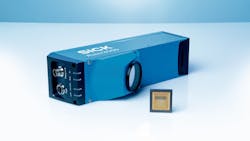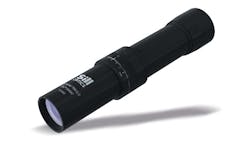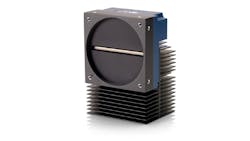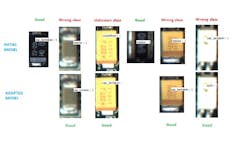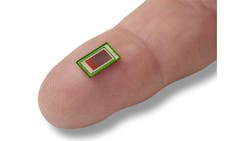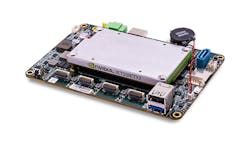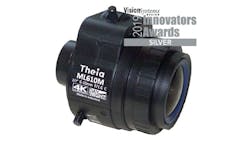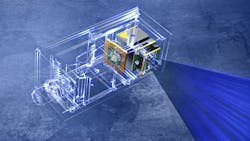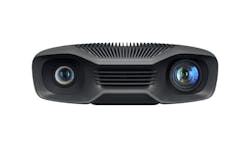VISION 2021 Product Preview
After a forced break in 2020, VISION is back in 2021. It will take place on October 5-7 in Stuttgart, Germany. More than 200 exhibitors are expected at the event. More than 50 key exhibition areas for system components, applications, and services are planned for the conference space. Exhibition areas for smart, area scan, line scan, high-speed, infrared, and hyperspectral cameras; lenses, filters, and illumination; frame grabbers and hardware platforms; and software libraries and application packages are among the 27 dedicated spaces in the system components category.
Following is a sampling of new innovations that will be on display at the show.
Click here for more information on VISION 2021.
VISION 2021: The long-anticipated return of machine vision’s influential trade fair
Alkeria - Hall 8, Stand C36
Alkeria is launching a USB3 line scan camera featuring a SWIR InGaAs sensor, NECTA S, capable of high-resolution acquisition in short-wave infrared bandwidth ranging from 950 to 1700 nm. This SWIR camera can reach up to a 40 kHz line rate with 14 bit A/D converter. It offers a high-speed USB3 interface, advanced I/O, and a compact and rugged aluminum case, making NECTA S suitable for many machine vision applications. The NECTA S comes in two versions: the NS05K, with 512 × 1 pixel resolution, and the NS1K, with 1024 × 1 pixel resolution. Both can be equipped with C-mount lens adapter.
Alkeria has developed a laser triangulation extension to provide its customers with a fast and reliable solution for their measurement and quality inspection issues. Alkeria cameras can define and extract the line position in every column of the acquired frame with sub-pixel precision. The Profilometer extension enables on-camera acceleration of the line position detection algorithm. Alkeria's cameras can extract and calculate profile coordinates by themselves, reducing the amount of data sent through the USB3 interface. Users can easily reach maximum sensor frame rate and collect only the data useful for the measurement. The system relies on the CELERA, CELERA One, and ARIA camera series.
Basler AG – Hall 8, Stand D50
Basler’s ace 2 Basic and ace 2 Pro are equipped with state-of-the-art CMOS sensor technology. The ace 2 features sensors from Sony, including the latest Pregius S sensors, and from Gpixel and offers resolutions up to 24 MPixels. At the same time, the cameras retain their compact format and are available with C-mount and with GigE or USB 3.0 interfaces. The difference between the ace 2 product lines, Basic and Pro, lies in the integrated features: a computer vision feature set for standard vision needs or the new Beyond features from Basler for more demanding tasks. The cameras are compatible with Basler’s accessory portfolio via the company’s pylon Camera Software Suite.
Baumer - Halle 8, Stand D40
Baumer industrial cameras featuring cooling pipes integrated directly into the housing allow the CX.XC models to be cooled with compressed air in the 2 to 3 bar range or with liquids up to 6 bar. Heat dissipation near the sensor and the lens allows CX.XC cameras to provide images with low noise and few defective pixels. Production for CX Series cameras with integrated cooling pipe will begin with 5 MPixel models with Sony Pregius sensors in Q4 2021. The CX camera series includes more than 130 models. Standard 29 × 29 mm CX Series units offer a choice Sony Pregius, Pregius S, STARVIS, and Polarsens as well as ON Semiconductor PYTHON CMOS sensors.
BitFlow - Halle 10, Stand H46
BitFlow has engineered two purpose-built frame grabbers featuring board-mounted micro fans to draw in cool air to replace hot air in SFF PCs. The Claxon CXP4 frame grabber is a quad CXP-12 PCIe Gen 3 frame grabber that supports one to four CXP-12 cameras and multi-link CXP-12 cameras, with CXP speeds from 3.25 to 12.5 Gb/S. The Cyton CXP4 frame grabber is based on the CoaXPress 1.1 standard and has a Gen 2.0 x8 PCI Express bus interface on its back end for high-speed access to host memory in multi-camera systems. Both frame grabbers support simple triggering modes and complicated, application-specific triggering, and control interactions within any hardware environment.
BitFlow’s Axion xB series will replace the Neon series of Camera Link frame grabbers. The Axion xB series is compatible with all CL Base cameras. The Axion 1xB is compatible with one CL Base camera. Also available are the Axion 2xB, compatible with two CL Base cameras, and the Axion 4xB, which is compatible with 4 CL Base cameras. The Axion xB is software compatible with all other current BitFlow frame grabbers. This makes migrating applications to/from Camera Link, analog, and CoaXPress simple and quick. The Axion xB also benefits from other products in BitFlow's line up. The Axion xB uses the Cyton-CXP's backend, for example, the StreamSync DMA engine and buffer manager.
CCS - Hall 10, Stand E54
The new OLB-LT bendable OLED lights from CCS utilize the flexibility of OLED technology to achieve backlighting that can be installed on curved inspection lines. Using multilayer technology, the OLB-LT provides the intensity and uniformity needed in machine vision applications, such as vial inspections or fluid level inspections, in a housing that is 4 mm thin. Two models will be available at release: either inner or outer surface as the emitting surface. The dedicated controller features Lifetime Prediction Technology that estimates the remaining time before the light unit needs replacement, optimizing efficiency for maintenance. Available in white.
Chromasens - Halle 10, Stand F30
Chromasens has introduced the allPIXA evo 8K, 10K, and 15K cameras that are fully compatible with the latest version of the CoaXPress (CXP 2.0) interface. By merging CXP 2.0 with trilinear CMOS sensors yielding resolutions up to 3 × 15360 pixels, the cameras acquire true RGB color, mono, or TDI images at a maximum line frequency speed of 100 kHz. Users can select from one, two, or four channels to target the exact data transfer needs of their applications. Each channel has a maximum transfer output of 12.5 Gbps (CXP-12) or a total of 50 Gbps of bandwidth if all four channels of the camera are connected to a GenICam compliant frame grabber.
CMICRO - Hall 10, Stand B81
CMICRO’s NDB100H is a SWIR dual-band camera using two InGaAs linear image sensors with 1024 pixel resolution. It features a dichroic prism with excellent spectral characteristics that splits input light into wavelength bands of 950 nm to 1345 nm and 1400nm to 1700nm, which are captured by two InGaAs sensors independently. The precise sensor alignment enables two sensors to capture completely the same scope in two SWIR wavelength bands. Camera output data corresponds to either Camera Link Base Configuration or GigE Vision interface and can be output digitally with 8, 10, or 12 bit gradation.
CMICRO’s Rosella series cameras, RSB400/200H, are prism-based high-end RGB line scan cameras with high resolution, fast scan rate, and high sensitivity. Three CMOS sensors with 4096 pixels of 7 μm square size (RSB400H)/2048 pixels of 14μm square size (RSB200H) are adopted. The maximum sampling rate is 160 MHz, and the maximum scan rate is 34 kHz (RSB400H) or 64 kHz (RSB200H). Precise sensor alignment enables the color drift to be reduced to almost zero, and two sensors can capture completely the same scope in the RGB bands. The data output format is Camera Link, and the cameras provide separate RGB image data with 8, 10, or 12 bit gradation.
Connect Tech - Hall 8, Stand C24
Connect Tech’s Rogue is a full-featured carrier board for the NVIDIA® Jetson AGX Xavier™ module. It is specifically designed for commercially deployable platforms and has footprint of 92 × 105 mm. Rugged camera add-on camera expansion boards are available for use with the Rogue to interface directly with the Jetson AGX Xavier high density MIPI CSI interfaces. Connect Tech’s GMSL camera platform is an expansion board that allows connection of up to 8 cameras. Powered through Power over Coax, all the data, control signals, and power are sent through a single 50 Ω coaxial cable, allowing for flexibility in cable routing and ease of installation in automotive applications.
DCM Sistemes - Hall 10, Stand D80
Discover the new AMS: iBlueSpectrum, a ringlight consisting of 4 segments and up to 8 integrated wavelengths that can be controlled independently. This new lighting also integrates the latest iBlueDrive technology and includes a micro strobe controller, which makes the device work in strobe mode as easily as in continuous mode. Users can decide which sector (or sectors) and which color they want to work with. The device has four independent sectors and up to eight integrated wavelengths (user’s choice), which will work independently. Having four sectors that work independently (multisector) allows users to quickly obtain multiple photos of the same scene illuminated from different angles to generate different shadows.
Euresys - Hall 10, Stand D70
To speed time-to-market of new CoaXPress-over-Fiber products from camera makers, frame grabber manufacturers and embedded vision system developers, Euresys has developed a series of IP Cores for devices (transmitter) or hosts (receiver). Euresys has also released the first CoaXPress-over-Fiber frame grabber, the new Coaxlink QSFP+, the latest member of its Coaxlink series. Readily adopted by several camera makers, CoaXPress-over-Fiber proposes an answer to the ever-increasing requirements for more bandwidth between the camera and the computer, higher frame rate, and higher image resolution. Originally developed by Euresys/Sensor to Image, CoaXPress-over-Fiber is the result of the cooperation between the members of the CoaXPress Workgroup.
To speed time-to-market of new products based on GigE Vision, USB3 Vision, CoaXPress, or CoaXPress-over-Fiber for camera makers, frame grabber manufacturer and embedded vision system developer Sensor to Image, a Euresys company, has released a series of IP Cores for devices (transmitter) or hosts (receiver) looking to fully implement these interfaces and underlying protocol. They are complemented by the Machine Vision Development Kit (MVDK), which allows the design translation into a fast and efficient implementation, with support for CoaXPress host and device reference designs, GigE Vision host and device reference designs, USB3 Vision device designs, Sony IMX imager interface designs, as well as various Enclustra FPGA modules with Intel and Xilinx FPGAs.
The Open eVision Deep Learning Bundle from Euresys is a set of three libraries (EasyClassify, EasySegment, and EasyLocate), tailored, parametrized, and optimized for analyzing images, particularly for machine vision applications. Based on large Convolutional Neural Networks, deep learning solves complex problems difficult or impossible to solve with so-called conventional computer vision algorithms. Learning by example, deep learning does not require the user to figure out how to classify or inspect parts, as it just learns, in an initial training phase, by being shown many images of the parts to be inspected. After successful training, it can be used to detect, segment, classify and count parts or defects.
The Open eVision 3D Bundle from Euresys is a set of four libraries providing 3D measurement, inspection, and localization functions for machine vision applications. Easy3DObject can automatically extract and measure 3D objects. Easy3DMatch features alignment functions to find the exact pose (position and orientation) of acquired 3D objects using a reference model. Easy3DLaserline provides the necessary functions to implement a high-precision calibrated laser line triangulation setup. The Easy3D Library manages 3D Depth Maps, Point Clouds, and ZMap objects and is compatible with a number of third-party sensors for a seamless integration. Finally, the 3D Viewer application completes the offering allowing it to interactively display Point Clouds and 3D objects.
The Euresys Coaxlink CXP-12 is a series of CoaXPress 2.0 frame grabbers. The Coaxlink Mono CXP-12 and Duo CXP-12 are one- and two-connection compact CoaXPress frame grabbers on a low-profile PCIe card design. As a single CXP-12 connection provides more bandwidth than Camera Link Full, they are a perfect upgrade for most applications. The four-connection Coaxlink Quad CXP-12 provides an aggregate net bandwidth of 40 Gbps, allowing acquisition from the fastest and highest resolution CoaXPress cameras available today. In addition, the whole Euresys Coaxlink CXP-12 range supports extra-long 40-meter cables, just using standard coaxial cables.
Excelitas Technologies Corp. - Hall 10, Stand G44
Excelitas Technologies® Corp. will showcase its latest applied microscopy and imaging optics innovations, including the LINOS d.fine HR 2.4/128 lens. The d.fine HR 2.4/128 3.33X high-resolution inspection lens is optimized for a magnification factor of 3.33X, achieving object resolution of up to 300 lp/mm across image circle diameters as large as 82 mm. By adding modular accessories, the d.fine HR 2.4/128 enables dual-support for both 12k/16k line sensors and large format area sensors providing maximum versatility for handling countless imaging tasks. It also features an aperture of 2.4 combined with low distortion of 0.1%.
Hamamatsu - Hall 10, Stand C26
Hamamatsu Photonics offers customized solutions including sensors, sensor modules, and cameras. The company has successfully reduced the number of defects that occur in the photosensitive area by optimizing the composition ratio of InAs and GaAs in the InGaAs photosensitive area. As a result, Hamamatsu was able to realize InGaAs area image sensors that can detect infrared light up to 2.55 μm. The product lineup also includes 1.69/1.85/2.15 μm cutoff wavelength types. The newly designed and manufactured original optimized circuits (ROIC) allowed a narrower transistor gate length to be achieved. The company was also able to shorten the electrical signal transmission path and achieve a frame rate of 507 fps maximum.
IO Industries, Inc. - Hall 10, Stand D70
IO Industries Inc. (IOI) will display its Redwood 654G71CCQ high-resolution camera with CoaXPress-over-Fiber output interface. Designed around Gpixel’s GMAX3265 global shutter CMOS sensor, the camera operates at a peak output of 65 MPixels at 71 fps. The fiber optic interface enables long-distance connectivity between camera head and vision system. Also, Bitflow (10H46) will display IOI's Victorem 26.2 MPixel 41 fps CoaXPress camera with its Claxon CXP frame grabber. At the MaxxVision booth (8C27) visitors can view a full series of IOI's compact high-resolution, high frame rate industrial cameras as well as its Volucam camera with internal recording to SSD.
Irida Labs - Halle 8, Stand C16
PerCV.ai - Industry 4.0 Package is an end-to-end AI software and services platform that allows development of Industry 4.0 solutions that employ computer vision and AI at the edge, run in real time, and become the "eyes" of the manufacturing process. PerCV.ai is integrating ML models for pallet/parcel/space identification, forklift/vehicle/fleet monitoring, and employee PPE detection. Together with vision system design, data management and ready-to-use deployment tools for on-device intelligence, the platform supports a cross-field, holistic, edge-AI approach that can transform bounding boxes to real-world, scalable systems. Common application scenarios include operations analytics, automated production line QA, inventory management, logistics optimization, and truck loading monitoring.
LMI Technologies - Hall 10, Stand F30
LMI Technologies will showcase its Gocator® 3D smart sensors for inline inspection. Visitors can also learn about LMI’s FactorySmart® approach to inline automation, inspection, and optimization. This approach goes beyond the simple data acquisition of standard sensors to provide a more intelligent solution to the real-world challenges of manufacturing today. Gocator delivers its FactorySmart promise through a complete, built-in 3D inspection platform that works seamlessly within the factory environment to improve production in any industry.
Mikrotron - Hall 10, Stand F30
The Mikrotron EoSens®21CXP2 is engineered for factory automation, laser triangulation, PCB inspection, metrology and other demanding imaging applications. It features a high-speed 21-MPixel CMOS sensor offering 5120 × 4096 pixel resolution at more than 230 fps. By taking advantage of CoaXPress Version 2.0, it transmits data at twice the rate of CXP 1.1. The interface supports data transmission of up to 4 lanes at 12.5 Gpbs. Extreme sensitivity results in high-contrast images even in very low light conditions, enabling it to be integrated into applications where lighting is a crucial point.
Neurala - Hall 8, Stand E60.10
Neurala’s Vision AI (VIA) software helps companies improve their quality inspection process through patented technology that reduces the amount of image data needed and eliminates the need for AI experts. Easy to set up and integrate to existing hardware, Neurala VIA software reduces product defects while increasing inspection rates and preventing production downtime—all without requiring previous AI expertise.
Neurocle - Hall 8, Stand B13
Neurocle’s NEURO-T is no-code software to train image-related deep learning models. Anyone can create a deep learning model with Neuro-T’s intuitive GUI and Auto Deep Learning algorithm. NEURO-R is a runtime API that helps model deployment and supports optimized integration with various inference platforms including GPU and embedded processors. The Auto Deep Learning algorithm is a unique algorithm of Neurocle that self-discovers the optimal deep learning structure and hyperparameters.
Opto Engineering - Hall 8, Stand D48
Telecentric lenses remain at the heart of Opto Engineering’s® DNA. Its latest additions include the TCEL series featuring telecentric optics with integrated liquid lens technology. Another product in the company’s portfolio is represented by the 360° view lenses where there are also interesting innovations starting from the PCHIAF lenses, optics for hole inspection with adaptive lens focus. PCBPN, boroscopic probes for diameters down to 5.5 mm and optional waveguide module, are also worth mentioning. The latest Opto Engineering lighting includes the LT2BC series with continuous high uniformity LED backlight, now also available with optional integrated collimation film. The company is excited about its LTBRZ3 series, LED bar lights with integrated drive electronics.
Optotune - Hall 10, Stand G25
Optotune’s FOV expansion module extends the FOV while maintaining high resolution. The setup allows reading 10-mil barcodes from a distance of several meters anywhere in the FOV without needing to move the camera. At the same time, the liquid lens enables focusing within milliseconds from 30 cm to infinity. The setup combines the Optotune EL-16-40 liquid lens and the Optotune MR-15-30 fast steering mirror. This product combination expands the field of view and depth of field of a standard imaging system. Even when using a 3 MPixel camera, the combination of Optotune‘s products results in an imaging resolution that surpasses the human eye, offers a FOV of 100° × 70°, and allows stitching of a 1500 MPixel image.
Photoneo - Hall 10, Stand C40
At VISION 2021, Photoneo, a developer of 3D machine vision systems and AI-powered automation solutions for industrial applications, will present its technology that powers the company’s MotionCam-3D 3D camera. Visitors will have a chance to see this high resolution, high accuracy area scan 3D camera for scanning scenes in motion that eliminates the trade-off between quality and speed. Visitors can try the camera out and get a 3D model of their own items. MotionCam-3D was introduced at VISION 2018 when it was recognized with the Vision Award 2018.
Prophesee, Hall 8, Stand B29
The Metavision packaged sensor is a third generation 640 × 480 VGA event-based sensor. Inspired by the human retina, each pixel of the Metavision sensor embeds its own intelligence enabling them to activate themselves independently, triggering events. Each pixel embeds its own intelligence processing enabling them to activate themselves independently, triggering events. By processing events, not frames, the vision processing can be done extremely fast and capture fleeting scene dynamics with a speed of >10k fps Time-Resolution Equivalent. With each pixel only reporting when it senses movement, Metavision sensors generate on average 10 to 1000x less data than traditional image-based ones.
Prophesee’s Evaluation Kit 3 enables fast, cost-efficient first hands-on evaluation of Prophesee’s event-based vision. Available in two versions, featuring the Prophesee 3.1 VGA sensor or 4.1 HD sensor co-developed with Sony Semiconductor Solutions, it is suitable for first hands-on evaluation and performance-constrained computing environments. It features USB 3.0 Micro-B connectivity, maximum system bandwidth of 1.6 Gbps, maximum system power of 4.5W, powered via USB, CS/S mount version availability, trigger in/out, and full compatibility with Metavision Intelligence Suite. Supported sensors include the Gen4.1 (HD – test sample) co-developed with Sony Semiconductor Solutions and the Gen3.1 (VGA – packaged sensor).
The Prophesee Evaluation Kit 2 HD enables full performance evaluation of Generation 4.1 event-based vision sensor co-developed with Sony Semiconductor Solutions. It is suitable for advanced evaluation and high-performance computing environments. Features include metal casing, USB Type-C connectivity, maximum system bandwidth of 3.0 Gbps, CS/S mount versions available, trigger in/out, and full compatibility with Metavision Intelligence Suite. Supported sensors include the Gen4.1 (HD – Test Sample) co-developed with Sony Semiconductor Solutions.
Prophesee’s Metavision® Intelligence Suite provides key modules in open source and extended support for machine learning to enable the fast-growing ecosystem of developers to adopt event-based vision technology. It offers 95 algorithms, 67 code samples, and 11 ready-to-use applications in total so you can either start your discovery or build your event-based vision product. Metavision Intelligence Suite is based on an open source architecture, unlocking full interoperability between Prophesee’s software and hardware devices and enabling a fast-growing event-based community. Metavision Intelligence Suite covers a range of machine vision fields, including machine learning, computer vision, camera calibration, and more.
SICK - Hall 10, Stand D58
At VISION 2021, SICK will showcase a new generation of Ruler3000 3D streaming cameras. The Ruler3000 combines SICK’s Ranger3 streaming camera with a Class 2 eye-safe laser, preselected optics, and fixed geometries to enable much simpler configuration and commissioning. With industry-standard compliance giving comprehensive access to machine vision software tools, the Ruler3000 cuts time and complexity when integrating more demanding inspection, measurement, and robot guidance tasks across a wide range of industries. Powered by SICK’s CMOS sensor and ROCC (Rapid On-Chip Calculation) technology, the Ruler3000’s integrated streaming camera scans reliably at rapid production speeds. It processes up to 15.4Gp/s to enable up to 7000 full-frame 3D profiles per second.
Sill Optics - Hall 10, Stand C33
Sill Optics designed a new 2.0x telecentric lens for sensor size up to diagonal 21.4 mm (1.25’’), pixel sizes down to 2.74 µm and working distance 68.1 mm. The C-mount lens fits to a range of cameras in applications with monochromatic and white illumination through the VIS waveband. Additionally, Sill Optics has introduced a version with integrated Optotune liquid lens to enable high speed working distance adjustment over a range of approximately 6 mm. Through this tuning range, a z-axis measurement within the focus adjustment is possible, too. The 2.0x lens starts a lens series including standard magnification of 1.5x, 2.5x, and 3.0x.
Teledyne - Hall 8, Stands A10 and B10
The Teledyne DALSA Linea HS 16K Multifield features charge-domain CMOS TDI sensor technology with 16k x (64+128+64) TDI arrays and a 5 × 5μm pixel size. The TDI camera can capture up to three images simultaneously in a single scan. Based on Teledyne DALSA’s CMOS TDI technology, the Linea HS Multifield™ camera has features that improve detectability for many demanding applications. The camera comes with high-speed fiber optic interface, delivering up to 8.4 Gigapixels per second over a single and long length fiber optic cable.
Teledyne Imaging’s Sapera™ Vision Software offers image acquisition, control, image processing, and artificial intelligence functions to design, develop, and deploy machine vision applications. In this release, the AI tool Astrocyte™ allows learning at runtime for increased flexibility and performance on deployed systems. Astrocyte is an application based on artificial intelligence dedicated to training neural networks on 2D images for various applications. Users can bring in their own image samples and train neural networks to perform classification, object detection, segmentation, and noise reduction. Astrocyte allows visualizing and interpreting models for performance/accuracy as well as exporting these models to files for later use at runtime into Sapera Processing and Sherlock.
Topaz CMOS Sensors, from Teledyne e2v are 2 MPixel (1920 × 1080) and 1.5 MPixel (1920 × 800) CMOS sensors that feature a low noise global shutter pixel. Ideal for mobile applications, the sensors use low noise, global-shutter pixel technology to offer solutions and enable compact mobile designs for many applications. Housed in a 4.45 mm wide chip scale package (CSP), the Topaz sensors have an optical array centre that precisely matches the mechanical centre of the package, allowing for a slim camera design.
Break through GigE Bandwidth barriers with Teledyne FLIR’s Lossless Compression feature that delivers up to 70% higher FPS with 100% data integrity. Lossless Compression is a feature available on select Teledyne FLIR GigE machine vision cameras that use its proprietary algorithms to compress image data. The compression occurs on camera before transmitting data to the host, enabling the cameras to transmit data at higher maximum frame rates, using lower bandwidth for data transmission while maintaining 100% image data. Once the data is transmitted to the host, it can be uncompressed or saved in its smaller, compressed form for lower disc space utilization.
Teledyne FLIR’s Quartet Embedded Solution for Nvidia TX2 allows for easy integration of multiple cameras including AI capability. The Quartet Carrier Board for TX2 enables easy integration and simultaneous streaming of up to 4x USB3 machine vision cameras at full bandwidth. This custom carrier board provides a fully integrated SOM design that optimizes size and cost by eliminating the need for peripheral hardware and host systems. By offering 4x TF38 connectors and dedicated USB3 host controllers per port, systems designers can integrate multiple fully featured machine vision board level cameras into their embedded vision systems.
Theia Technologies - Hall 10, Stand B64
Theia’s 6-10 mm ML610M 4K varifocal is compatible with 4K cameras up to 12 MPixels and covers up to 3 primes with 51-87 degrees horizontal field of view on a 2/3” sensor, providing 300 lp/mm resolution with <9 µ focus shift in NIR for multispectral imaging. The lens is vibration-resistant to of 20-200 Hz at 10 G/axis yet compact and lightweight in a 70 g, 52 × 59 mm envelope to fit into small space requirements. Available in C-mount and manual iris versions.
TriEye - Hall 8, Stand E60.11
Based on advanced nanophotonic research, the TriEye Raven is an HD CMOS-based VIS-SWIR sensor, ranging from 0.4 to 1.65 µm, that enables unique SWIR capabilities for multiple industrial applications. SWIR sensing enables vision in adverse conditions, remote material sensing, mounting behind glass, seamless integration, and usage of existing VIS AI algorithms. TriEye’s sensor is CMOS-based, which enables HD resolution, low power consumption, and small form factor. The TriEye Raven can be easily integrated into industrial machines and production lines, providing vision capabilities and critical information required by machine vision systems.
Vision Components - Hall 8, Stand C31
Vision Components will present new developments at VISION 2021. The company recently launched VC picoSmart, a complete embedded vision system, and has now equipped it with new functions for 3D profile measurement. The company will also show VC Coax, a solution that allows transmission paths of 10 meters and more. Vision Components has optimized the cables for high-speed transfer. Vision Components offers various MIPI camera modules up to 20 MPixels that are compatible with all major single-board computers, as well as developer kits with robust functions for industrial applications. Further innovations are in preparation, including an FPGA-based hardware accelerator for image processing.
Zivid - Hall 10, Stand F53
Zivid One is a 3D color camera that offers 25 µm point precision and greater than 99% dimension accuracy. Users can capture high quality 3D images of industrial objects, including reflective metallic, black and absorbing, or partly translucent materials. Point clould data (XYZ) and RGB colors are captured with the same sensor chip. The factory calibrated 3D camera features an intuitive GUI, interfaces for machine vision software, and a modern and high level API.
The Zivid Two industrial 3D camera uses time-coded structured light to produce native color 3D point clouds. It is designed to image traditionally challenging shiny or reflective objects and has a 112 millimeter baseline for higher pixel coverage, especially relevant for imaging small parts. A unique combination of native colors and high dynamic range enable both single and mixed SKU bin applications and densely stacked or randomly arranged scenarios. Zivid Two’s new vision engine provides specific patterns, Artifact Reduction Technology, and new 3D hand-eye calibration and in-field correction tools. The camera is palm-sized, weighing less than 900 grams.

